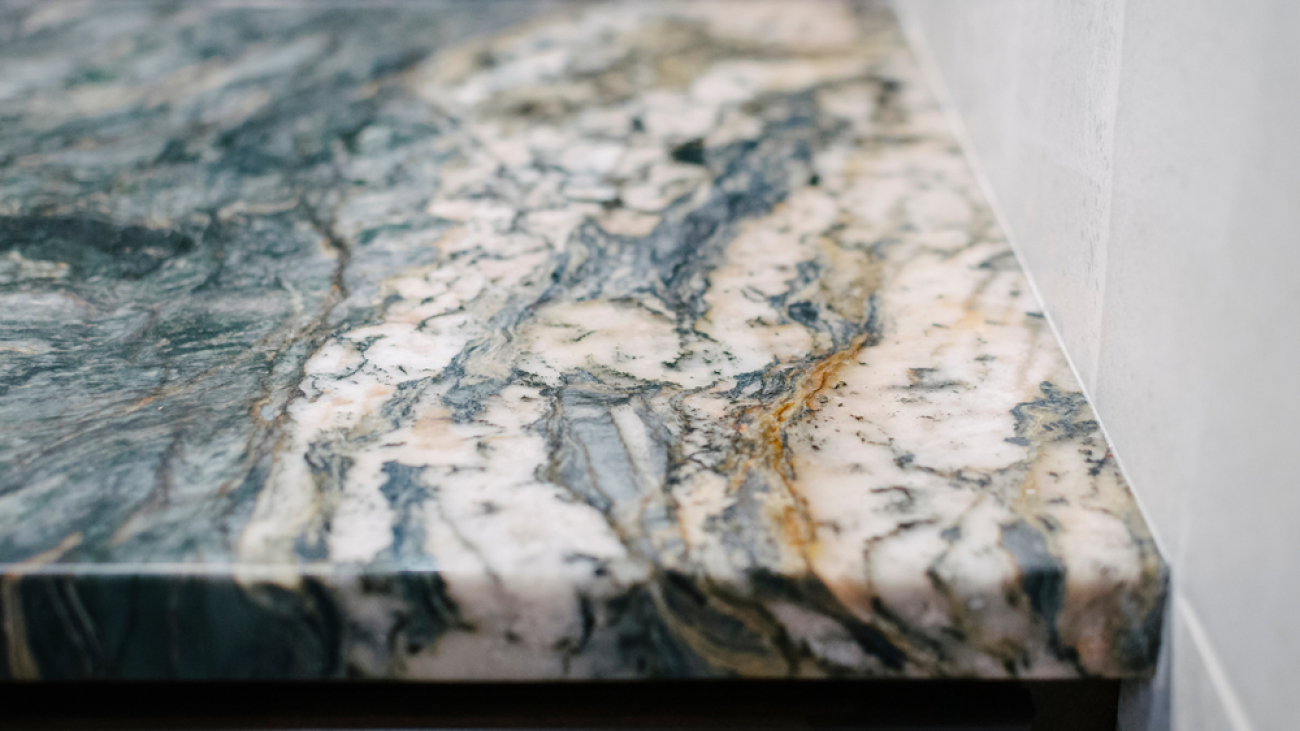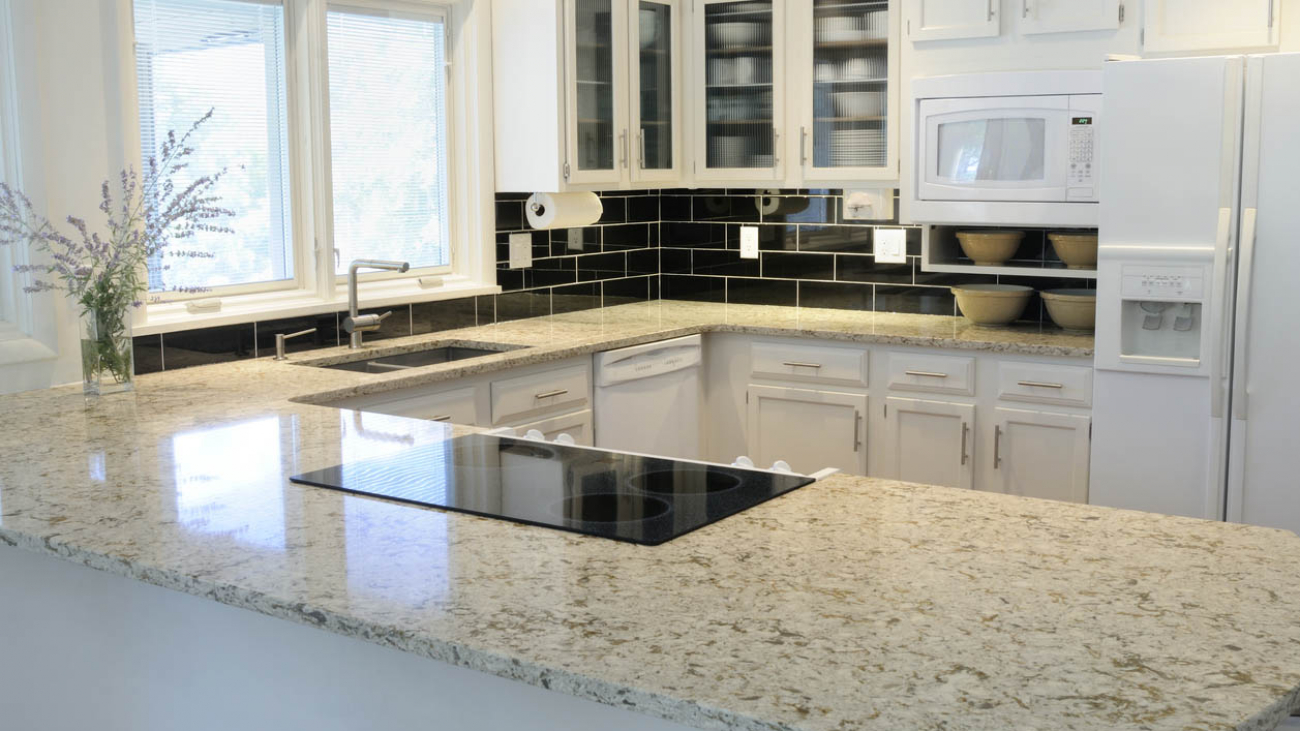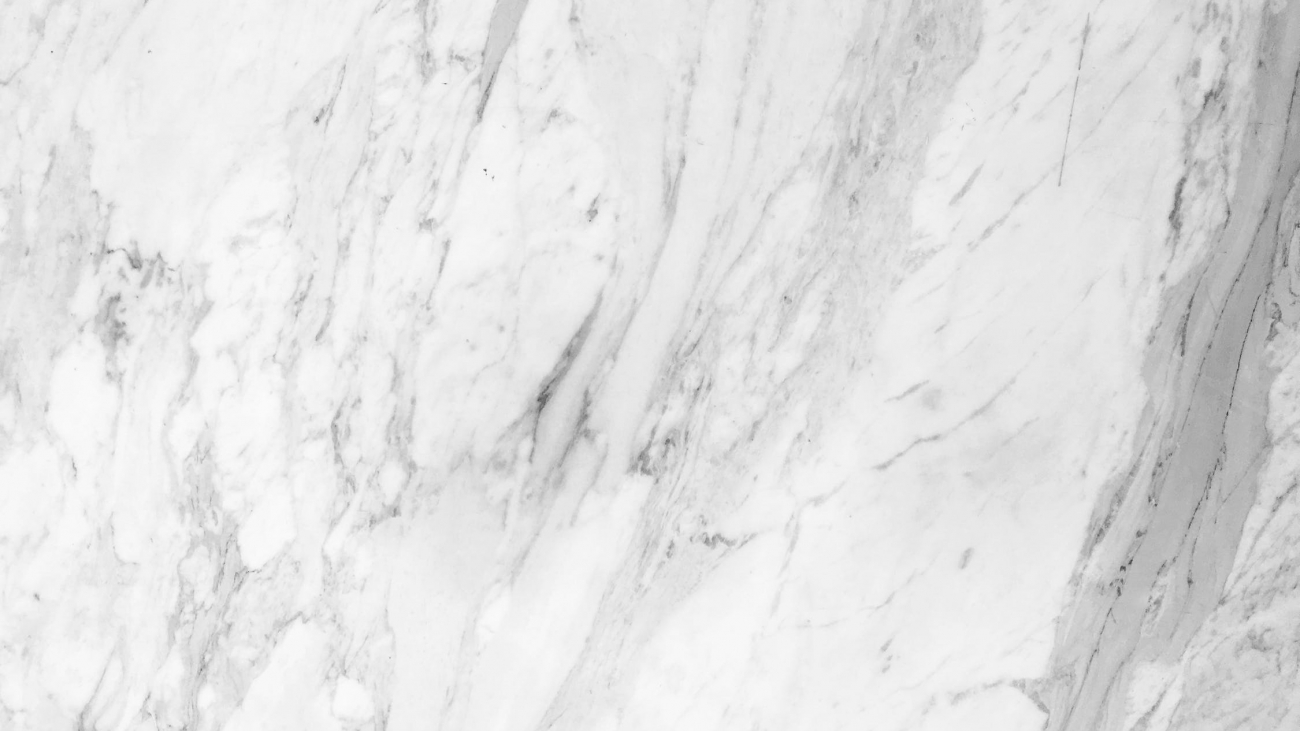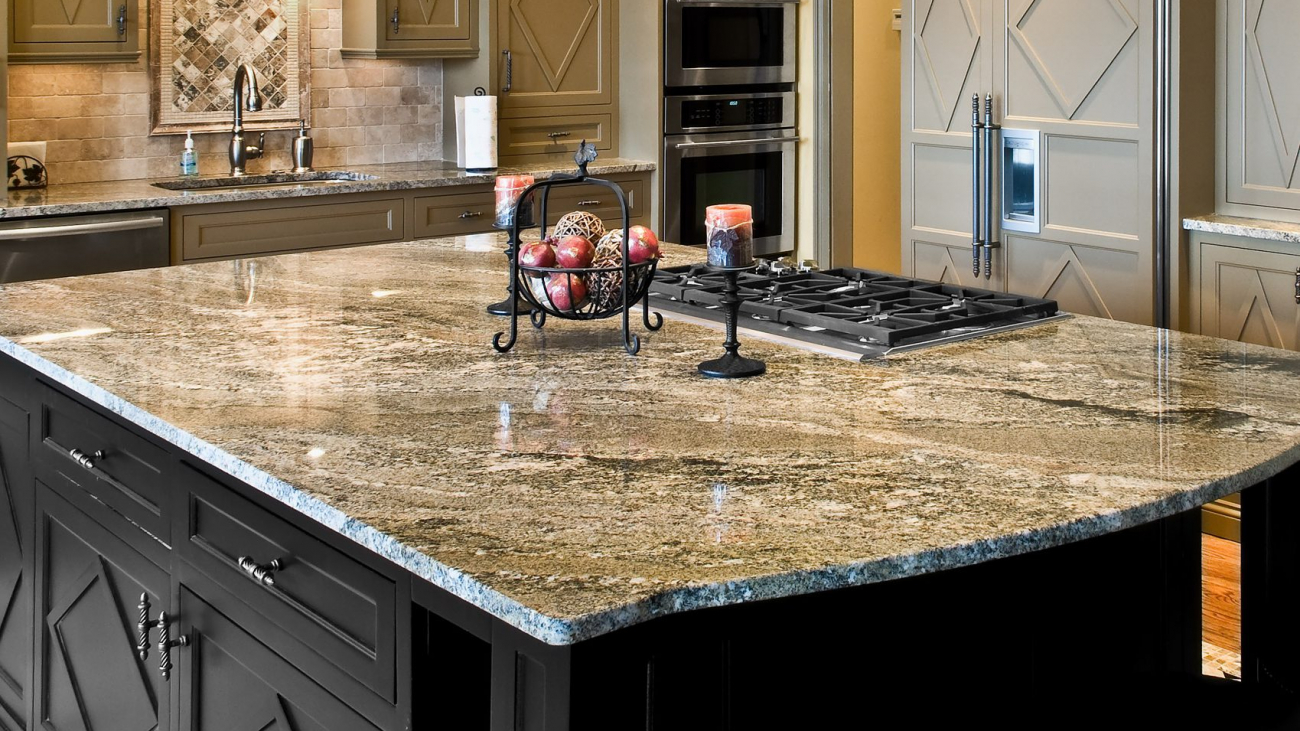Granite is a natural stone countertop material that is very popular in kitchens due to its aesthetic, 100-year lifespan, and it’s ability to withstand the heat of hot pots and pans. Granite countertops are easy to maintain and can be found in many different colors, styles, and finishes.
Granite kitchen countertops are popular for a reason!
As a quarried natural stone, granite is a type of igneous rock that occurs naturally within the Earth. In other words, different regions have different granite colors and patterns occurring naturally as opposed to something like quartz, which is manmade.
Here our stone experts take a look at the most popular granite countertop colors for 2021.
Let’s go!
Kitchen Granite Trends 2020/2021
Before we get into the most popular granite colors for 2021, it’s good to take a look at popular granite trends that are taking hold across the kitchen design space.
Here are the latest kitchen countertop trends you might want to consider for your granite in 2021:
Neutral Tones
Neutral toned granite colors are very big at the moment, with numerous countertop specialist designers recommending neutral whites, creams, light grays, soft blues, beiges, and many other natural mid-tone colors.
The great thing about neutral toned granite countertops is that they go with basically everything so long as they fit into the color scheme. There are multiple color options for neutral-toned granite slabs, so you’re spoilt for choice.
If you don’t want your countertops to be the focal point, neutral is a great choice.
Popular countertop colors that can be classed as neutral-toned include butterfly beige granite. This granite countertop is beige in color, featuring flecks of black, cream, and white throughout. Colonial white granite is another popular neutral this year – a white granite with black/gray details.
Leathered Finish
Leathered finish is not a granite countertop finish for everyone, but it’s certainly making a name for itself as a bold piece of kitchen design in 2021. Leathered granite has a textured, rough surface and no sheen or light-reflecting qualities at all, so it’s usually found in open spaces and darker colors.
While a textured granite countertop might not sound all too appealing, this unique granite is great at hiding stains, etches, and signs of everyday wear and tear. This makes leathered granite great for chaotic kitchen environments, especially in darker colors that hide dirt even more.
If you’ve got a larger kitchen space with lots of natural light, this finish could be an excellent choice!
You’ll usually find this unique finish in black granite countertops, as it’s the best material for helping the rough texture blend into a seamless kitchen design. Though leathered black granite is the most common granite color in this finish, you can find shades of gray, coffee brown, and even white too.
Unique Veining & Patterns
Distinctive veining and patterns are back for 2021, with many homeowners opting for granite countertop materials that attract attention and draw the eye, serving as the impressive focal point of the kitchen design. Look for mineral deposits, veins, color flecks, and other distinctive patterns of natural stone.
Busy designs with multiple color variations or a number of criss-crossing veins and patterns are very popular with homeowners and designers recently – the more complex the appearance of the surface, the better. Just make sure the rest of the kitchen design is toned-down enough to handle it!
Popular granite countertops in this style include:
- River White Granite – Popular granite slab from India which is white with linear gray veins that resemble interconnecting rivers
- Blue Granite – Made from deep blues and mid-tone blues, this dramatic granite slab has interconnecting veins of various blues that resemble waves crashing through the ocean
- Picasso Granite – Grey granite filled with chunks of greys, blacks, and white that create a visually striking Picasso-esque art style
- Blue Pearl Granite – In similar deep blues to Blue Granite, Blue Pearl is a variation featuring a dazzling array of color flecks in various blue hues for a more chaotic feel
There are many popular granite colors that fall into this category, but these are just some popular examples.
Honed/Matte Finish
Looking for a granite slab that is toned down, calm, and natural-looking? Granite counters in honed finishes (aka “matte finishes”) are very popular in 2021 so far, boasting a classy low-sheen finish that reflects a small amount of light, giving a low-matte sheen similar to eggshell finish paint.
In a well-designed modern kitchen, this granite style can look effortlessly chic.
Praised for its ability to disguise dirt, stains, and etches in the slab, honed finish granite is an excellent practical choice too. It’s usually found in simple shades of black and gray, though you can also find complex granite designs that have been honed, helping to hide dirt even better.
Most Popular Granite Countertop Colors 2021
While popular granite colors are always going to be changing, there are several specific shades that homeowners and people in the kitchen design space are gravitating toward in 2021.
Make sure to check out these 14 popular granite countertop colors before buying anything for your home:
Alaska White Granite
Light white with darker flecks of color, Alaska White Granite is perfect for pairing with dark kitchen cabinetry to produce a striking black and white design. This unique style of white kitchen countertop is actually reminiscent of snow, so it’s perfect for a space with a cool-toned color story and stainless steel appliances.
Black Galaxy Granite
Black Galaxy Granite is as cool as it sounds. Deep black with specs of white, gray, and jet black make for a space-esque granite slab that goes perfectly with white cabinets, again creating that classic modern high-contrast black and white aesthetic in reverse.
Namibian Gold Granite
Gold with medium brown and khaki hues too, this speckled stone comes with flecks of black and deep greyish veins, making it perfect as a focal point of your kitchen. Depending on what exact granite color you get from the slab, it could also work as a neutral granite countertop too.
Picasso Granite
Inspired by the unusual painting style of Pablo Picasso, Picasso Granite is a greyish granite filled with busy patterns and chunks of color. Usually found in variations of grey, black, and white, this is quite possibly the best type of granite finish for that impressive focal point appearance.
Black Pearl Leather Granite
Black Pearl Leather Granite is very dark – mostly black with subtle flecks of blue and gray tones spread throughout. The leather finish creates a textured surface that makes Black Pearl practical and very unique. Paired with white cabinets, Black Pearl is great in both modern and transitional kitchens.
Azurite Granite
Similar to the Picasso Granite, Azurite Granite boasts huge veins, specks, and chunks of color that almost feel chaotic. Veins and color chunks are a mix of browns, blues, creams, and golds, though the overall appearance of the granite slab is a type of gold-tinged grey that feels very opulent and expensive without trying.
Typhoon Green Granite
This type of granite can vary slightly in color from olive green to deep brown depending on where the granite slabs were cut from. While the green granite is more popular than the brown granite, both varieties are very rare and sought after due to their impressive natural highlights.
White Ice Granite
White Ice Granite is white with flecks of blue and gray tones, making this stone ideal for cool-toned kitchen spaces. This white granite countertop is often paired with black kitchen cabinets and stainless steel hardware for an ultra-modern appearance.
Almond Gold Granite
Pure gold hue with speckled highlights of brown and beige, Almond Gold originally comes from Brazil. Like most of the best granite from Brazil, this stone can fit into a variety of home designs, though it’s often used as a neutral-toned countertop.
Blue Pearl Granite
Blue Pearl Granite is a speckled design featuring a variety of deep and medium blue tones, giving the granite a sleek, cool, modern feel. Often paired with white cabinets, you’ll see this granite style make an appearance in many kitchens – both traditional and modern.
Nordic Black Granite
Made in Canada despite the name implying it’s from Scandinavia, this granite is naturally very dark and the stone is finished with a suede-like texture. White and silver veins almost make this stone look liked cracked marble, so it’s perfect for an opulent, high-end design.
Costa Esmerelda Granite
Boasting greenish hues that certainly attract attention, this granite style is best paired with wood cabinetry in a complementary color, fitting into a kitchen color story. This speckled green-hued stone works well with brass or gold kitchen hardware to help the unique hues pop against each other.
Andromeda White Granite
Andromeda White is a white slab speckled with white and beige color flecks. This granite counter also comes with silver and green-tinged color deposits throughout, creating an even more impressive tiger-stripe aesthetic. Pair with dark cabinetry for an excellent modern aesthetic.
African Ivory Granite
Said to resemble a Google Maps view of the desert, this cream-colored granite is adorned with hues of cream, gold, blue, and gray. Great as a neutral granite counter, the natural earthy colors of this stone make it ideal for many people’s kitchen color schemes.











